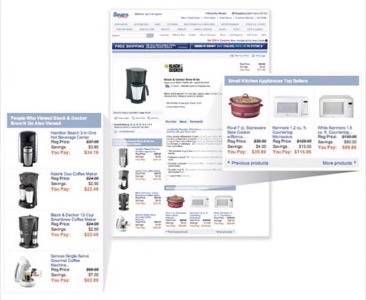Last week we looked at Baynote, a recommendations company that focuses on real-time community behavior instead of personalization. Today we look at a company that takes a broader approach: richrelevance uses personalization extensively, plus the wisdom of the crowds when relevant. richrelevance claims that its approach is “adaptive AI” and that customers such as Sears and KMart are using its technology. We spoke to richrelevance founder and CEO David Selinger (ex-Amazon), to find out more about the product and what makes it different to Baynote and others.

As background, David Selinger once led the research and development arm of Amazon’s Data Mining and Personalization team. Selinger told us that he worked for “chief algorithms officer” Udi Manber at Amazon,
where his role was to improve Amazon’s recommendations technology (note: Manber is now one of Google’s vice presidents of engineering). After Amazon, Selinger worked at Overstock and eventually created his own recommendations company, richrelevance, which licenses its technology to e-commerce websites.
As we noted in our previous post, our series on recommendation engines has shown that every company in this market – including those which create their own platform, like Amazon and Netflix – have differing approaches and ideas on what makes a good recommendation engine. The key to richrelevance’s approach, Selinger told ReadWriteWeb, is that people don’t shop the same and so different recommendation types will be used for each shopper. This is markedly different from Baynote’s approach, which specifically excludes a user’s past shopping behavior and instead focuses on real-time community patterns.

In the worldview of richrelevance, shoppers at Amazon are different to the ones at Sears – one of the companies using richrelevance’s technology. Furthermore, a person who has a shopping history at a store is different from someone who is totally new to that site. So, unlike Baynote, richrelevance takes into account a user’s purchase history – if known.
If we look at an example from Sears, on this item page the richrelevance recommendations display in two places: on the left there is a ‘People Who Viewed x Also Viewed’ box, and at the bottom of the page there is a ‘Top Sellers’ section. Selinger told us that if a Sears user has a long purchase history, then they will see recommendations in Sears based on that. We asked if they need to be logged in to Sears as a registered user, but Selinger told us that it is cookie-based and so doesn’t take into account their registered Sears user profile.

richrelevance’s Technology: Is it Better Than Baynote’s?
We were curious about why richrelevance thinks its approach is superior to those that exclude personal user bahavior, like purchase history (such as Baynote). Selinger told us that richrelevance constantly runs A/B tests, just as Amazon does, in order to find out what the most effective methods of recommendation are for any given customer (e.g. Sears) or individual user. This approach leads to using a mix of ‘wisdom of the crowds’ and ‘personalization’.
The theory is that the consumer will tell you what kind of recommendations they like – e.g. at Sears users may like item-based recommendations in certain products, but personalization in other products. Selinger used the analogy of the ‘personal shopper’; richrelevance tries different ways to help users shop, finding the best way by trial and error. There are different types of interaction for each customer, said Selinger.
We asked how this approach works for a brand new customer, because presumably there will be no shopper history to use. Selinger replied that richrelevance “works good straight away, but takes a while to get great recommendations”. So they may start out with a new customer using existing data that richrelevance owns (e.g. from a similar vendor), and then gather and test data about the new customer.
As for the technology behind richrelevance, David Selinger has termed it “ensemble learning”. In a recent blog post, in response to ReadWriteWeb’s Guide to Recommender Systems post, David Selinger wrote that “no ‘single algorithmic’ approach can hope to keep up with today’s ever-changing consumer mindset”, so richrelevance doesn’t try to force retailers and consumers “into a single bucket”. Instead Selinger says that richrelevance has “built a system that adapts to the retailer and to each customer in real-time”, which is done via “an adaptive type of artificial intelligence called Bayesian Ensemble Learning.”
In a comment on a recent RWW post, Selinger claimed that “algorithms like collaborative filtering are a thing of the past” and that ensemble learning is the next generation beyond that.
Conclusion
Ultimately, only the customers of richrelevance and Baynote know if their recommendations are working. Both companies claim that their technology results in higher sales for their e-commerce customers – richrelevance says it results in a “5%-30% sustained sales lift” for its customers. It’s difficult for ReadWriteWeb to corroborate those kinds of figures. What we do know is that Baynote is more focused on community behavior, whereas richrelevance takes both community and personal data into account – including purchasing history, which Baynote excludes.
We get the impression that richrelevance’s approach is very broad – perhaps too broad? In an email thread with David Selinger, he told us about some of the different forms of recommendations:
“…there can be basic contextual (you’re looking at Adidas, here’s more Adidas) or social contextual (you’re looking at these Adidas, people who looked at it eventually bought this); you can have basic behavioral (yesterday you looked at Adidas, here’s more Adidas), or social behavioral (yesterday you looked at these 10 things, people who looked at those eventually ended up buying one of these 3 things); or basic profile (here’s something from your wishlist) to social profile (you seem to like rock music, here’s some new rock music).”
That’s a lot of data that richrelevance is trying to process, in real time. Let us know in the comments whether you like richrelevance’s adaptive approach to recommendations, or whether you think Baynote’s more focused approach is better.










